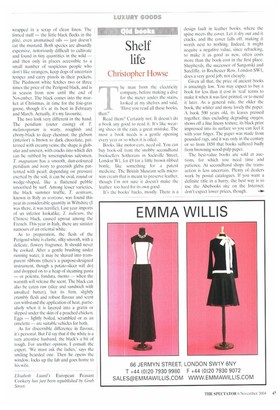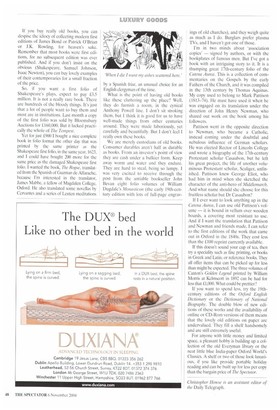Shelf life
Christopher Howse
T he man from the electricity
company, before making a dive for the meter under the stairs, looked at my shelves and said, 'Have you read all these books, then?'
Read them? Certainly not. It doesn't do a book any good to read it. It's like wearing shoes in the rain, a great mistake. The most a hook needs is a gentle opening every year or so when it is oiled.
Books, like motor-cars, need oil. You can buy book-oil from the snobby secondhand booksellers Sotherans in Sackville Street, London Wi, for £9 for a little brown ribbed bottle, like something for a patent medicine. The British Museum sells microwax cream that is meant to preserve leather, though I'm not sure it doesn't make the leather too hard for its own good.
It's the books' backs, mostly. There is a design fault in leather books, where the spine meets the cover. Let it dry out and it cracks, and the cover falls off, making it worth next to nothing. Indeed, it might acquire a negative value, since rebacking, to make it as good as new, often costs more than the book cost in the first place. Shepherds, the successor of Sangorski and Sutcliffe, in Rochester Row, I,ondon SW1, does a very good job, not cheaply.
Given all that, the price of ancient books is amazingly low. You may expect to buy a book for less than it cost in 'real' terms to make it when it was first printed, or to mend it later. As a general rule, the older the book, the whiter and more lovely the paper. A book 500 years old, its leaves pressed together, thus excluding degrading oxygen, shows off a fine lineny texture, its black print impressed into its surface so you can feel it with your finger. The paper was made from pounded rags, and it was only in the century or so from 1850 that books suffered badly from browning wood-pulp paper.
The best-value hooks are sold at auctions, for which you need time and patience. At secondhand shops the transaction is less uncertain. Plenty of dealers work by postal catalogues. If you want a definite title in a hurry, the best way is to use the Abebooks site on the Internet; don't expect lower prices, though. If you buy really old books, you can despise the idiocy of collecting modern first editions of James Bond or Patrick O'Brian or J.K. Rowling, for heaven's sake. Remember that most books were first editions, for no subsequent edition was ever published. And if you don't insist on the obvious (Shakespeare, Samuel Johnson, Isaac Newton), you can buy lovely examples of their contemporaries for a small fraction of the price.
So, if you want a first folio of Shakespeare's plays, expect to pay £3.5 million. It is not a really rare book. There are hundreds of the bloody things. It's just that a lot of people want to buy them and most are in institutions. Last month a copy of the first folio was sold by Bloomsbury Auctions for £160,000. But it lacked practically the whole of The Tempest.
Yet for just 1900 I bought a nice complete book in folio format the other day that was printed by the same printer as the Shakespeare first folio, in the same year, 1623, and I could have bought 200 more for the same price as the damaged Shakespeare first folio. I wanted the book, The Rogue, translated from the Spanish of Guzman de Alfarache, because I'm interested in the translator, James Mabbe, a fellow of Magdalen College, Oxford. He also translated some novellas by Cervantes and a series of Lenten meditations
by a Spanish friar, an unusual choice for an English clergyman of the time.
What is the point of having old books like these cluttering up the place? Well, they do furnish a room, in the cynical Anthony Powell line. I don't sit stroking them, hut I think it is good for us to have well-made things from other centuries around. They were made laboriously, yet carefully and beautifully. But I don't feel I really own these books.
We are merely custodians of old books. Consumer durables aren't half as durable as books. From an investor's point of view they are cash under a bulkier form. Keep away worm and water and they endure. They are hard to steal, being so lumpy. I was very excited to receive through the post from the amiable bookseller John Bevan eight folio volumes of William Dugdale's Monasticon (the early 19th-century edition with lots of full-page engrav
ings of old churches), and they weigh quite as much as I do. Burglars prefer plasma TVs, and I haven't got one of those.
I'm in two minds about 'association copies' — signed by authors, or with the bookplates of famous men. But I've got a book with an intriguing story to it. It is a thumping great 17th-century folio of the Catena Aurea. This is a collection of commentaries on the Gospels by the early Fathers of the Church, and it was compiled in the 13th century by Thomas Aquinas. My copy used to belong to Mark Pattison (1813-74). He must have used it when he was engaged on its translation under the direction of John Henry Newman, who shared out work on the book among his followers.
Pattison went in the opposite direction to Newman, who became a Catholic, instead coming under the doubtful and nebulous influence of German scholars. He was elected Rector of Lincoln College and wrote a biography of the 17th-century Protestant scholar Casaubon, but he left his great project, the life of another voluminous Protestant scholar, Scaliger, unfinished. Pattison knew George Eliot, who had him in mind when she sketched the character of the anti-hero of Middlemarch. And what name should she choose for this fruitless scholar but Dr Casaubon?
If I ever want to look anything up in the Catena Aurea, I can use old Pattison's volume — it is bound in vellum over wooden boards, a covering most resistant to use. And if I want the translation that Pattison and Newman and friends made, I can refer to the first editions of the work that came out in Oxford in the 1840s. They cost less than the £100 reprint currently available.
If this doesn't sound your cup of tea, then try a speciality such as fine printing, or books in Greek and Latin, or reference books. They all offer items that can be picked up for less than might be expected. The three volumes of Caxton's Golden Legend printed by William Morris at Kelmscott in 1892 can be had for less that £1,000. What could be prettier?
If you want to spend less, try the 19thcentury editions of the Oxford English Dictionary or the Dictionary of National Biography. The double blow of new editions of these works and the availability of online or CD-Rom versions of them means that the lovely old editions on paper arc undervalued. They fill a shelf handsomely and arc still extremely useful.
For anyone with little money and limited space, a pleasant hobby is building up a collection of the old Everyman library or the neat little blue India-paper Oxford World's Classics. A shelf or two of those look luxurious, if you like provide portable holiday reading and can he built up for less per copy than the bargain price of The Spectator.
Christopher Howse is an assistant editor of the Daily Telegraph.



























































































































 Previous page
Previous page